SFDC objects and workflows
Salesforce Integration
As a Salesforce admin that connects Default with your CRM, you will be listed as a user creating all records. A best practice is to have a dedicated Integration User with admin permissions to authenticate Salesforce to take away any confusion from the Created By field being the human Default admin.
Start the Integration by following this guide.
Navigate to the Integrations tab within Default.
Select Salesforce to connect, manage, or disconnect your CRM integration.
Records and Field Mapping
In Salesforce objects, you can pass data such as form submission answers, enrichment data, or custom values to any Salesforce field. There are 2 values to consider when mapping fields.
Dropdown on the top maps Default data.
Dropdown on the bottom maps your Salesforce instance's fields.
Tip: When mapping fields, try selecting the bottom value first. This often clarifies where you should source the top value of your data. Plus, if the bottom field is a pick-list, Default will pre-populate the pick-list options.
Create, match, and update records
Create
Create Salesforce Record objects allow you to create any Salesforce record and pass form submission answers, enrichment data, or custom values for any field (including custom fields).
Important: As a critical step, make sure you have completed the User Mapping!
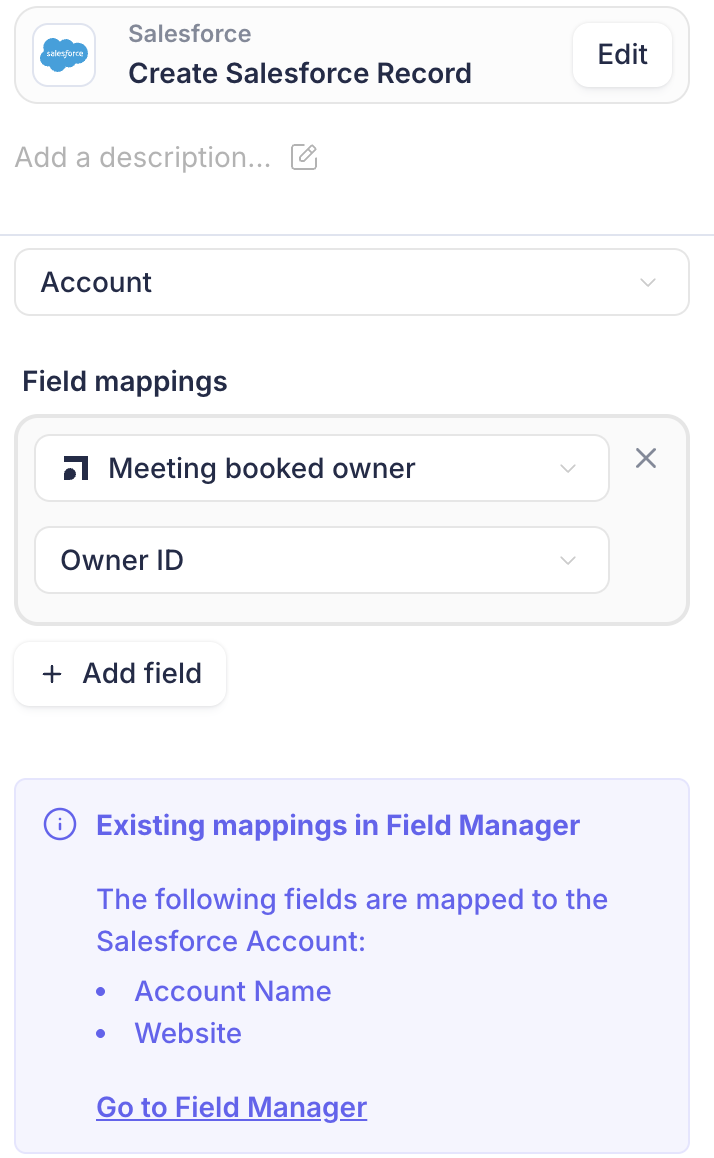
Tip: To save time and avoid repetitive work, set up your common lead attributes in User Mapping. Any additional fields not covered there will still need to be mapped directly in the create object of your workflow.
Match
Salesforce Match objects allow you to find any Salesforce record. Match objects can create 2 paths for objects that match or don't match your set criteria.
You can stack as little or as much criteria as you want. If you have duplicate records you can prioritize those records. The example below shows if multiple Accounts come back with the same name, Default can pick the one that has the most recent activity (hence Last Modified Date = Max).
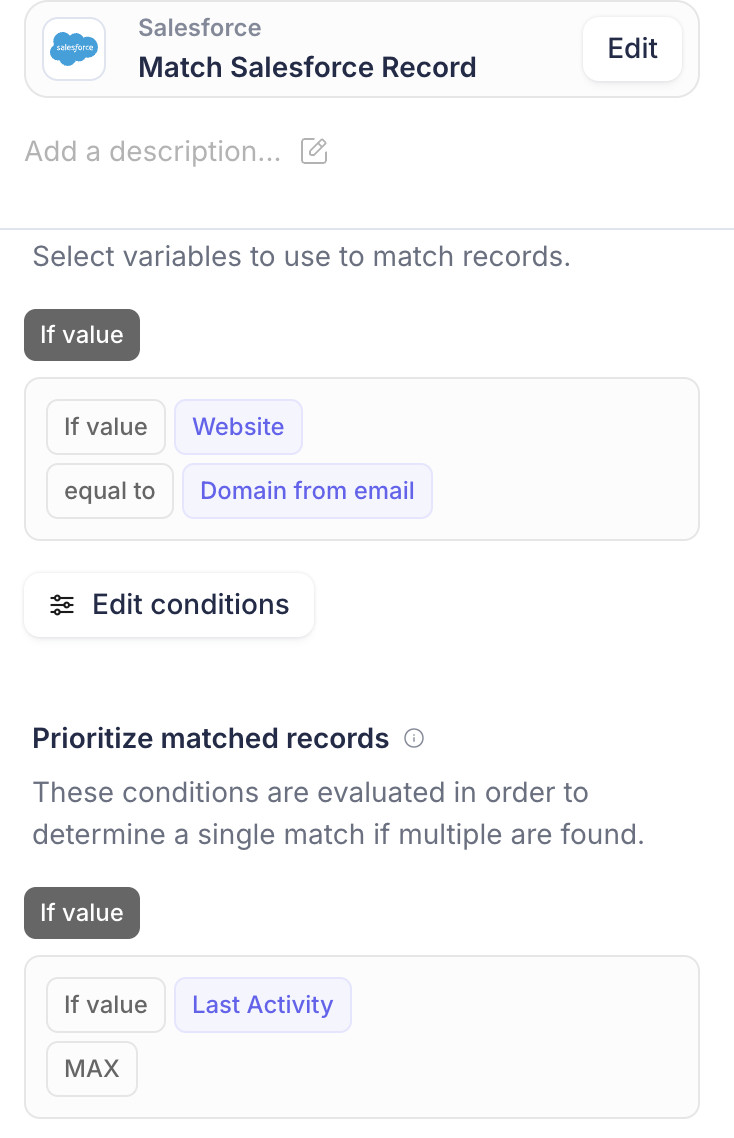
Update
Salesforce Create objects allow you to update any Salesforce record with new data such as form submission answers, enrichment data, or custom values for any field (including custom fields).
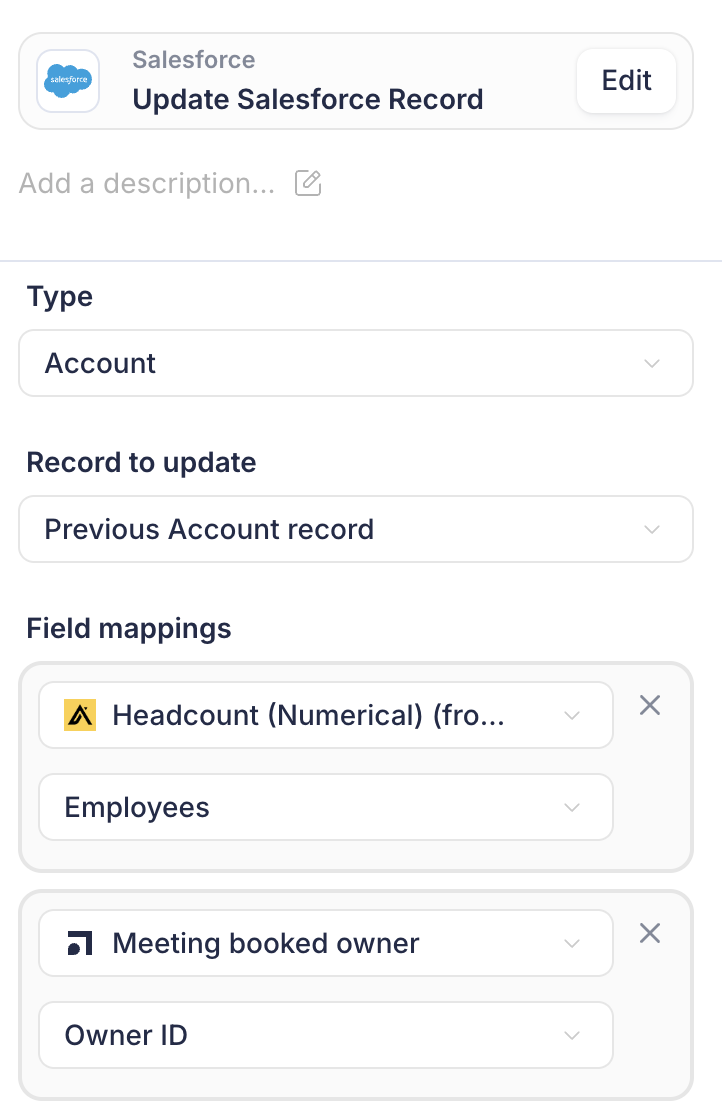
SFDC Objects
Default supports the following Salesforce objects:
Leads
Default allows you to create, merge, and match Leads. You don't have to use any other tool to send lead information for subsequent posting to Salesforce.
Here's how it works:
Leads are submitted via the imported form from your website into Default
Default utilizes various criteria, including form question responses and our enrichment data, to match existing Leads, Contacts, or Accounts (including fuzzy matching)
If a match is found, Default can update the fields you specify in Salesforce.
If there is no match, Default creates a new record in Salesforce using the data provided from the form submission enrichment data, or a combination of both.
Contacts
Default allows you to create, update and match contacts. If Lead-to-Contact conversion is desired during your workflow, it's best to use the Match Salesforce object and look for a Contact with Lead's attributes.
Accounts
Default allows you to create, update, and match Accounts. If Lead-to-Account conversion is happening during your workflow, it's best to use the Match Salesforce node and look for an Account with Lead's attributes.
Convert Salesforce Lead
Default allows you to convert a lead to a contact and create a new account or connect to an existing account using a Convert Salesforce Lead object. You can also convert a lead to an existing contact and an existing opportunity.
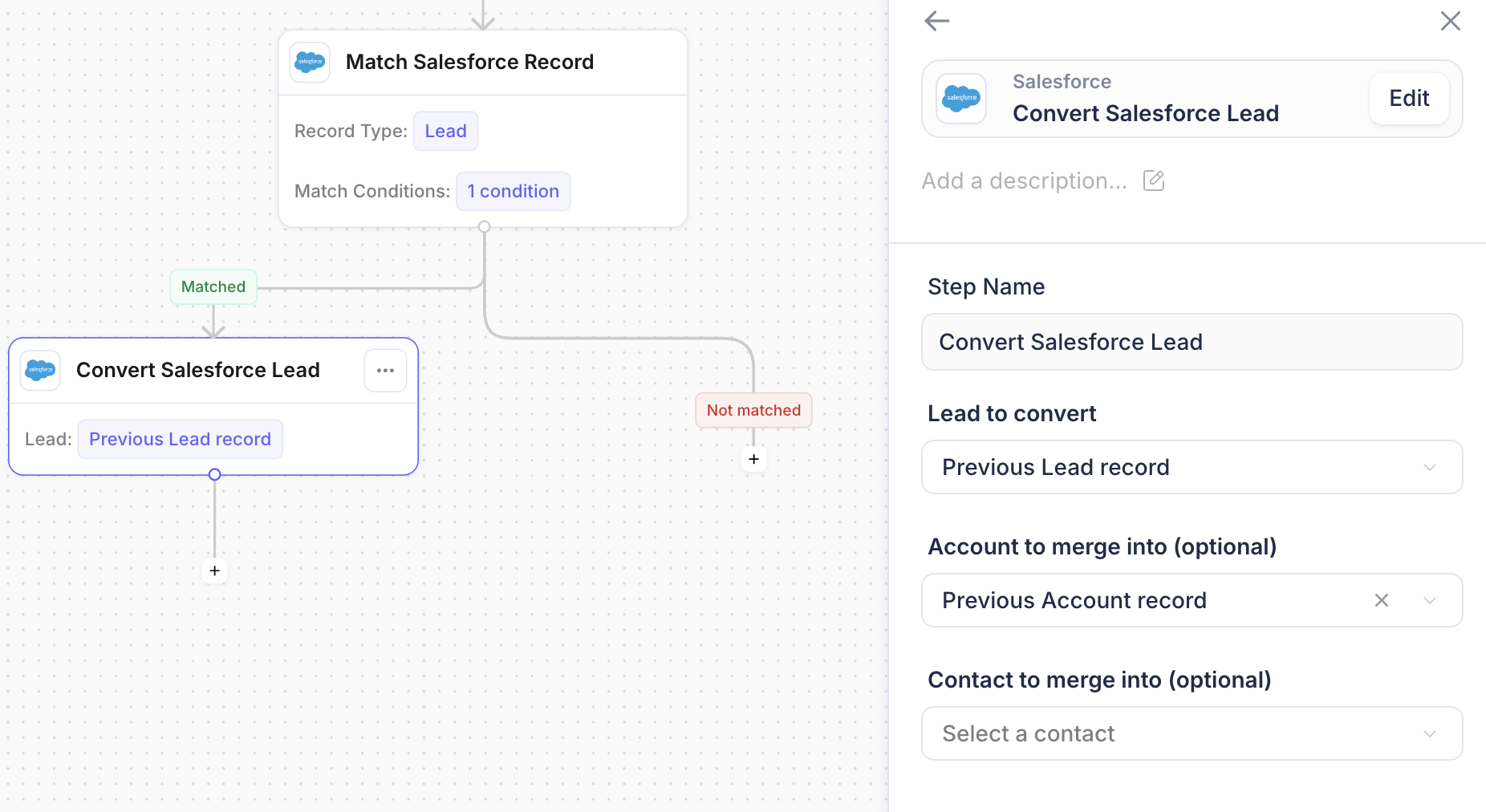
Here's how it works:
Leads are submitted via the imported form from your website into Default.
Default utilizes various criteria, including form question responses and our enrichment data, to match existing Leads, Contacts, or Accounts (including contains as a way to fuzzy match).
If a match is found, Default can update the fields you specify in Salesforce.
Thereafter, you can add the Convert Salesforce Lead object to convert the lead.
Convert the lead and specify if a new account needs to be create or an existing account needs be merged. You also have the option of creating an opportunity with an existing contact while converting a lead to a contact.
If creating an opportunity is not part of your current workflow when converting a lead, you can toggle off within that option in the object.
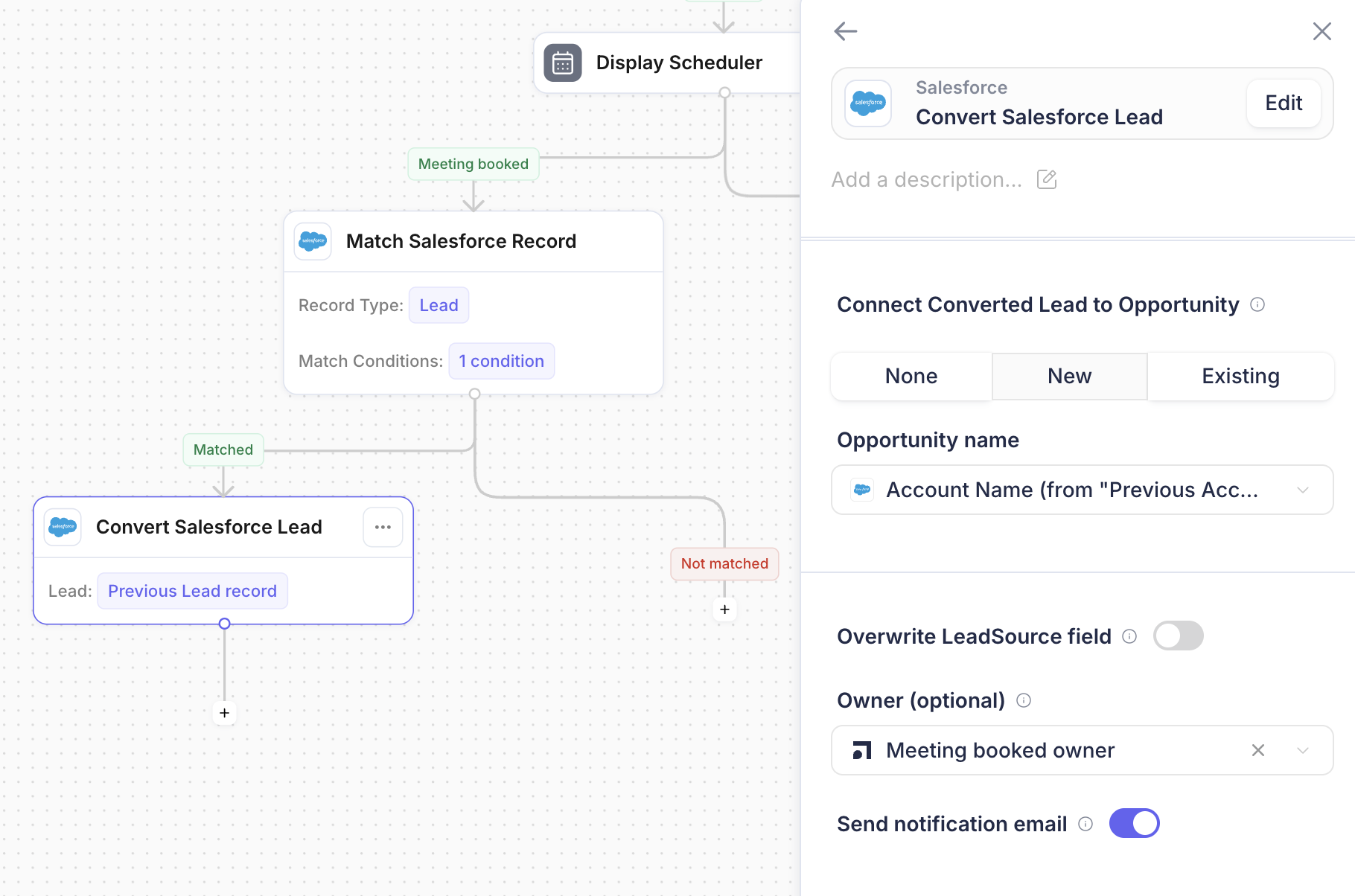
Optional SFDC Objects
Default also supports you to create, match, and update on the following objects:
Opportunity
Opportunity Contact Role
Events
Campaign Member
Here's how it works:
Leads are submitted via the imported form from your website into Default.
Default utilizes various criteria, including form question responses and our enrichment data, to match existing Leads, Contacts, or Accounts.
Use the operator contains for fuzzy matching.
If a match is found, Default can update the fields you specify to Salesforce.
Creating an Opportunity and an Opportunity contact role
Here's how it works:
Use the Create Salesforce Record object to create an opportunity and pass the form submission answers, enrichment data, or custom values for any field (including custom fields).
IMPORTANT: When creating a record, there are field-level requirements to abide by in SFDC. Follow the same set of rules in Default when creating a SFDC record and mapping the fields in a create object.
Opportunity
These are also common mapped fields, please reference your CRM for any additional required fields for creating an Opportunity and field mapping for optimal results. Common fields can also include:
Opportunity Name
Account ID
Name ID
Stage
Record Type ID
Close Date
Owner ID
Custom property (Check with your CRM Admin for for additional required properties)

In some cases, Opportunity Contact Role is required. Use a create SFDC object to create the Opportunity Contact Role.
Opportunity Contact Role
These are also common mapped fields, please reference your CRM for any additional required fields for creating an Opportunity and field mapping for optimal results. Common fields can also include:
Contact ID
Opportunity ID
Primary
Role
Custom property (Check with your CRM Admin for for additional required properties)
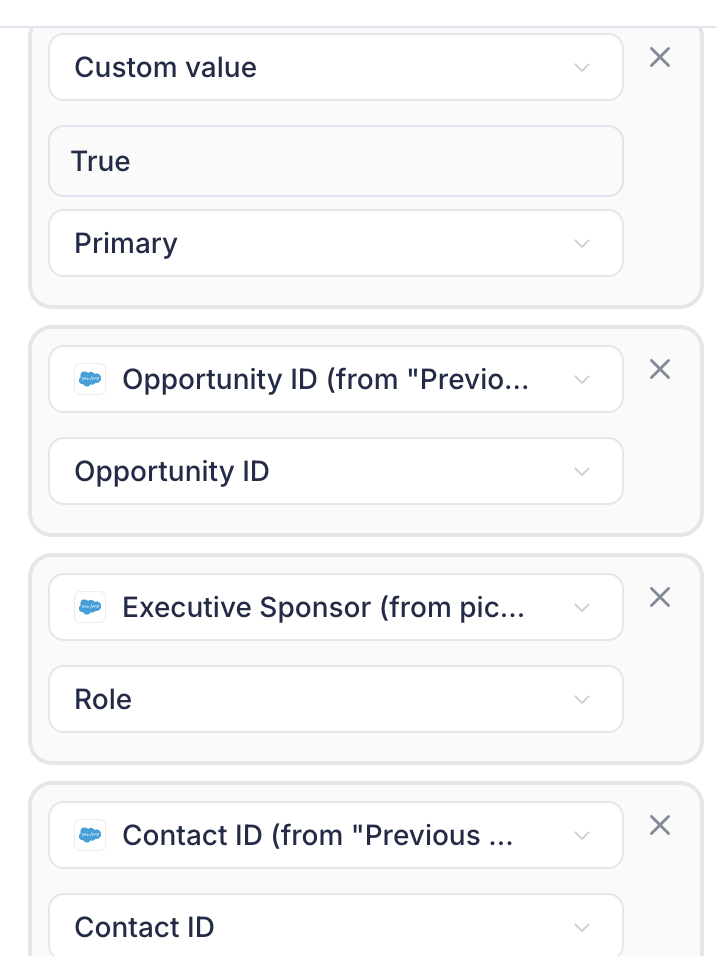
Events
These are also common mapped fields, please reference your CRM for any additional required fields for creating an Opportunity and field mapping for optimal results. Common fields can also include:
Name ID
Related to ID
Subject
Start Date/Time
Duration
Assigned to ID
Custom property (Check with your CRM Admin for for additional required properties)
In some cases, if you are associating an Opportunity to an Event, use Related to ID to map to the Opportunity and then map Account ID to the Account.
Account ID
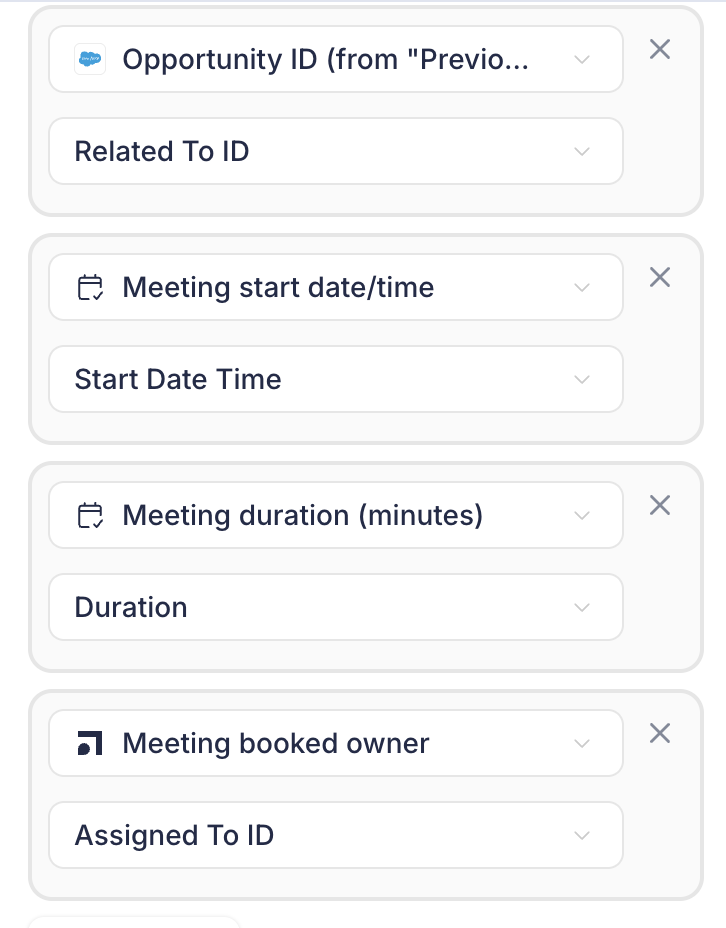
Routing
Assigning User to an Object
Default can assign any Salesforce record using the Round-Robin object.
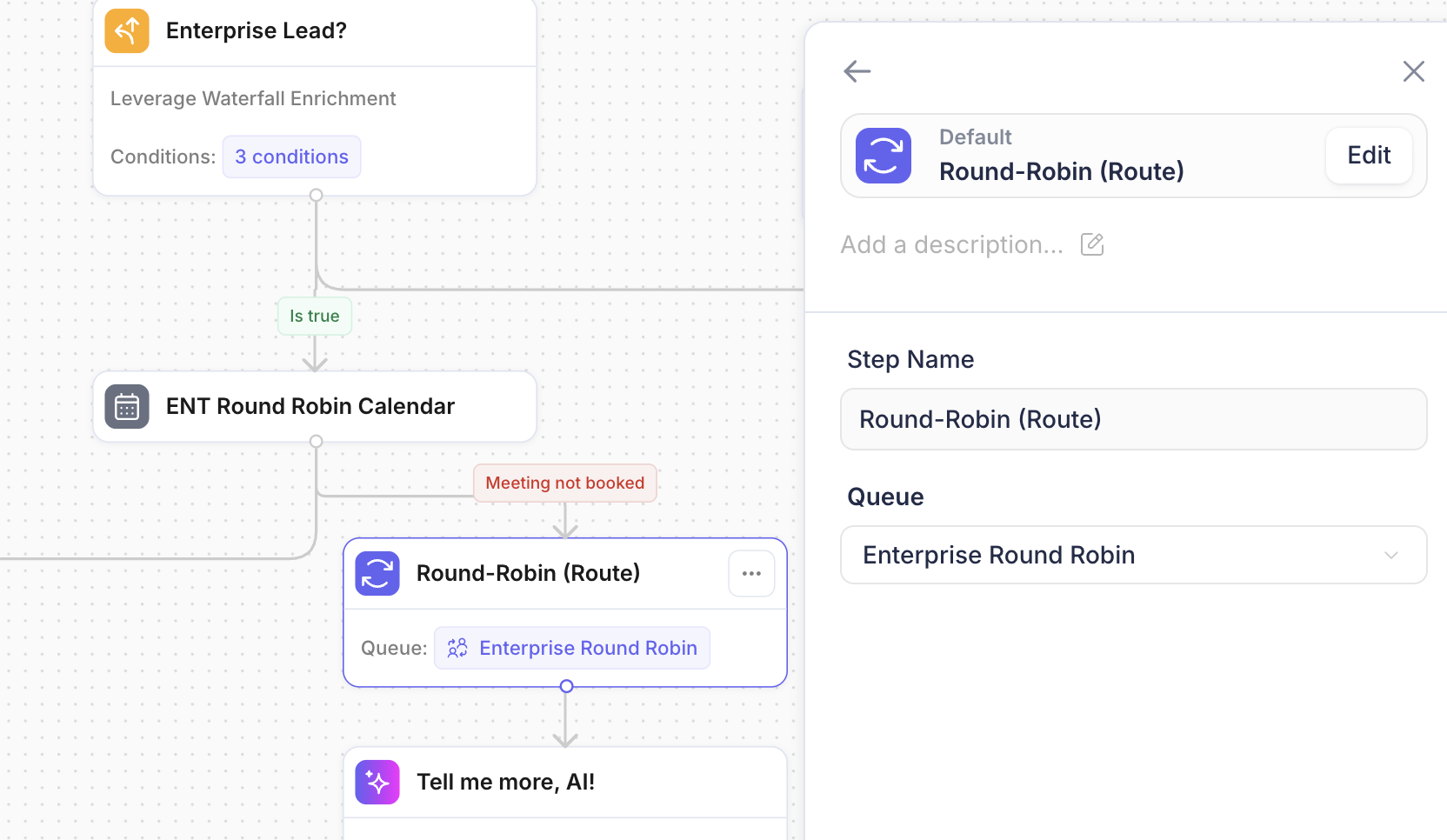
Form Submission -> Round Robin -> Round Robin Assignee made owner of Salesforce Record
Here's how it works:
When assigning a record, select a Round-Robin object and configure based on which Queue Default should route. A Round-Robin object can also be used on the no meeting is booked branch or when assigning a record.
Select a Create SFDC Record object to create the new record.
Map Owner to Latest Round-Robin assignee to the Owner ID field.
Note: If you want to update the existing record's Owner, first you need to select a Match SFDC Record object and then select a Update SFDC Record object and update the Owner ID field following the same instruction from above.
Ownership-based routing
Default uses the email address of a lead or contact to run through the configured logic, matching it to ownership fields—typically the owner_id in Salesforce. Once a match is identified, Default deterministically displays the calendar for the corresponding record owner, ensuring accurate routing, within seconds.
Here's how it works:
Configure the Match SFDC record node to find a record in question.
Select a Queue/Member called, Owner from the previous step while configuring the Display Scheduler node.
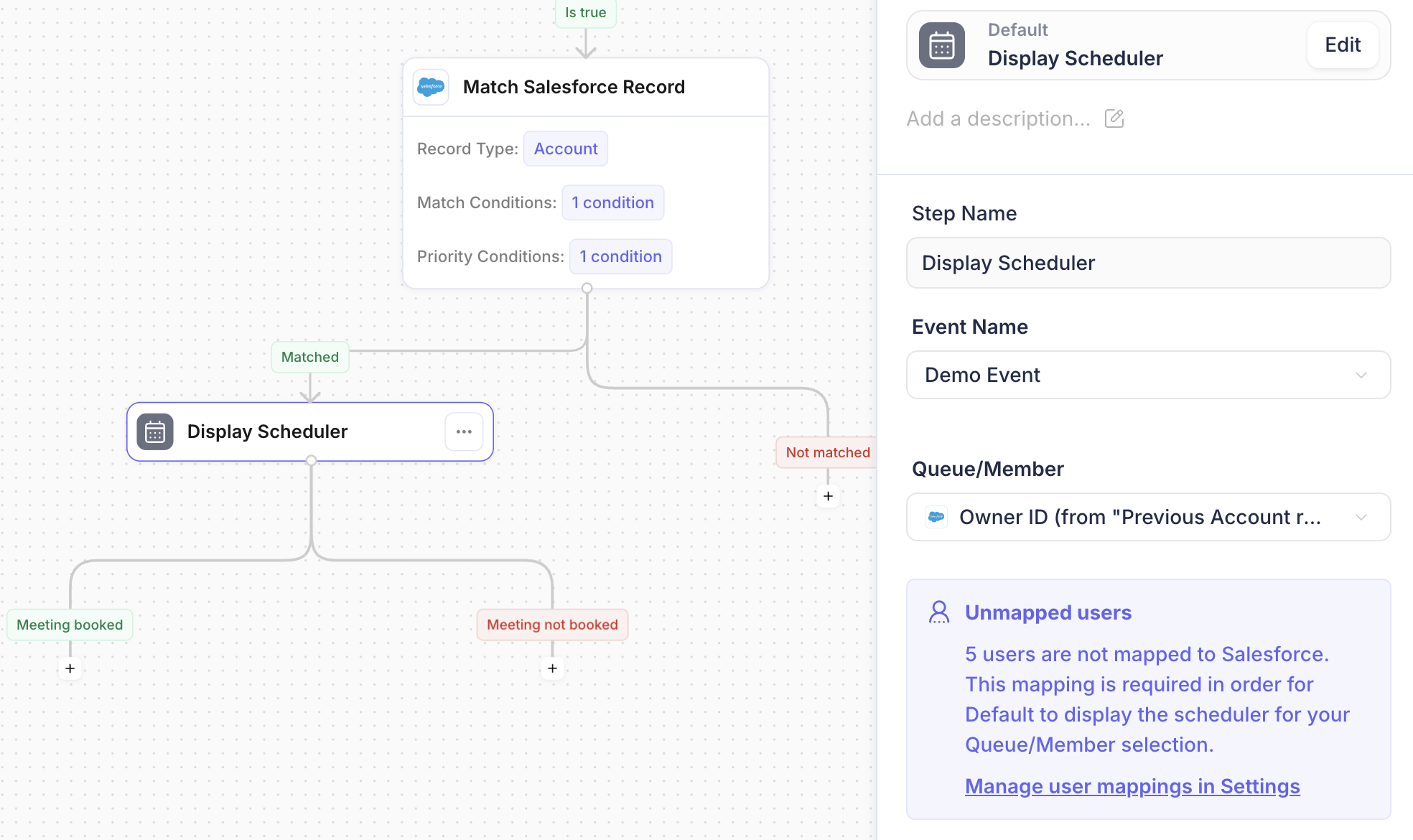
Note: We suggest always including fall backs when picking record owners in the off-chance a record owner does not exist and/or is not mapped back to Default.
Duplication logic
Default is designed to efficiently manage duplicates while creating leads in Salesforce.
Duplicate Verification
Default checks for duplicates by verifying if the email address is already registered in Salesforce. If a duplicate is found, Default can refrain from generating a new lead.
Here’s how it works:
Match and Prioritization
Default first searches for a matching lead in Salesforce using a Match object.
If a match is found, Default can prioritize it using the configured logic within the Match Records object.
If no match is found, Default can create a new lead.
Bypassing duplicate checks
If your workflow requires sending all leads to Salesforce without checking for duplicates, Default can be configured to create a new lead for every submission.
This flexible approach ensures your lead management process aligns with your specific business needs.
Creating Duplicates
This often stems from Salesforce’s default de-duplication logic not aligning with your business requirements. To address this, we’ve introduced an optional toggle on the Create Salesforce Record node (see below).
Here's how it works:
When the toggle is enabled, you can specify a field (e.g., email) to check for duplicates.
If no match is found for the specified field, Default will create a new record.
Example use case:
Existing record: joe.smith@apple.com is already a Lead in Salesforce
New submission: joe.smith2@apple.com submits a form
Salesforce’s default logic: considers this the same Lead due to overlapping criteria
Default’s match field logic: with the match field set to email, Default identifies that the emails do not match and creates a new Lead record instead

Toggle in a create object > enable match field > select field to use when a match is found
Prioritizing Mapping with Duplicates
To handle prioritization in cases of duplicate accounts, you can utilize the prioritization logic available under the Match SFDC record object.

This functionality allows you to establish priorities based on other fields associated with the Account.